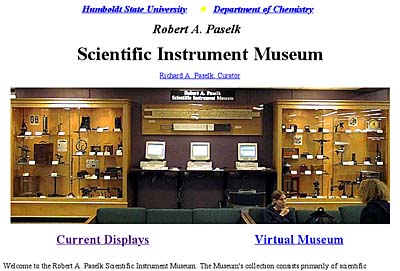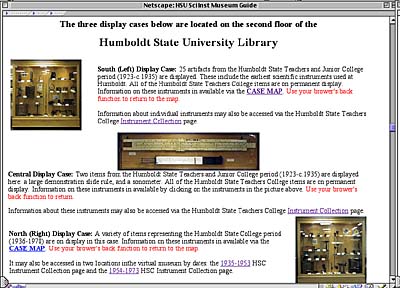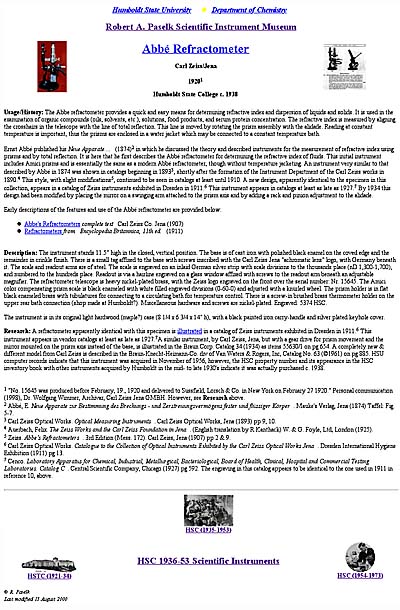![]()
![]()
![]()
![]()
![]()
![]()
![]()
![]()
![]()
![]()
![]()
![]()
![]()
Archives & Museum Informatics
158 Lee Avenue
Toronto, Ontario
M4E 2P3 Canada
info @ archimuse.com
www.archimuse.com
| |
Search A&MI |
Join
our
Mailing List.
Privacy.
published: April, 2002
From Virtual to Reality—How the Web Led to the Creation of the Robert A. Paselk Scientific Instrument Museum
Richard A. Paselk, Humboldt State University
Abstract
In this paper the origins and development of a small Web museum are described. In particular, the effect of the Web in the creation of this museum is emphasized, and the relationship between the Web museum and its physical displays are presented, along with a description of the museum itself. Some of the tools and strategies used in the essentially single-handed creation of a small museum on the Web are also discussed.
Key words: Small museums; virtual museum; scientific instruments.
While many museums have been creating Web sites over the past few years, the creation of a small scientific instrument museum was inspired and enabled through the Web at Humboldt State University (HSU). The Robert A. Paselk Scientific Instrument Museum began as a virtual museum on the Web. The museum originated from a personal collection composed of a variety of objects from the Chemistry and Physics departments at HSU which had been discarded or sold as surplus. A few of the instruments were displayed in a cabinet in a faculty office, while the rest were stored in closets and cupboards.
Shortly after the University began hosting Web sites it was determined to create a "museum" of apparatus which had been used at Humboldt and put it on a personal faculty Web -site. Preliminary research and documentation, including photographs, of many of the objects had already been accomplished as they were collected over the previous decade.
The first task in creating the museum was to convert the existent text and imagery into HTML and gif or jpeg format compatible with the Internet. Nearly ten years leading a multimedia project developing educational software for chemistry provided an excellent starting point, including experience with Adobe Photoshop™ and a familiarity with the concepts of hypermedia. Initial work, however, was highly dependent on the Courseware Development Center (CDC) at Humboldt State University. Created to aid faculty in developing on-line courseware, the CDC staff helped to scan photographs and diagrams, and to convert word processor documents to HTML. More important, they provided initial training required to continue this work independently, and suggested the use of the Web authoring tool, Adobe PageMill™, to create HTML. PageMill™ really made the virtual museum a practical reality, since it made the creation of HTML largely transparent and similar to standard word processing—it has remained the main Web authoring tool for the museum to this day.
Unlike many Web museums the R. A. Paselk Scientific Instrument Museum has always emphasized content and depth of information, a reflection perhaps of its design, creation, and curation by a university chemistry professor. A guiding principle in the creation of the museum site has been "content first, beauty later." As a result the museum site is mostly text based, with monotony broken by arranging text and images using table formatting, and changing font size and style rather than embedding text in graphics. This has the advantage for the small museum with limited staff and resources of being simple and quickly accomplished.
Having the museum site largely text based has the additional advantage of a rapid load time—it minimizes the "world wide wait." A text-based site also gives the visitor something to do while the images load - read. In the original site all photos and scans were presented as linked thumbnails, again with a rapid load-time in mind. This consideration has been largely maintained in the site, with the exception of main "index" pages which are decorated with full size photos.
The resultant on-line museum met with a very positive response from collectors and the international community of scientific instrument museums. In 1999 the interim Dean of the College of Natural Resources and Sciences at HSU noted the on-line museum and suggested the instruments should have a permanent home on campus. After some discussion, the Dean suggested the University Library as an ideal location to provide public access to what he considered an important asset to the College and the University. The Dean initiated discussions with the Library Dean; they were positively received, and led to a series of meetings with the Library Council to discuss an appropriate space and design for the displays. The difficulty was to design displays which would fit into the library and enable the continued use of the Web as catalog and museum guide. The actual design of the display was accomplished with the invaluable aid of Martin Morgan of HSU's Art Department, and HSU's Plant Operations staff who constructed the two main cases.
With the advent of a physical home for the museum, it became obvious that the Web site needed some redesign to fulfill its new "kiosk" function near the displays. In accomplishing this redesign, the Web museum was conceived in terms of three museum functions:
- As a repository of documented, described, artifacts.
-
As a source of context for the artifacts - who used them, what were they used for, how were they used.
- As a way of placing the artifacts and their use within the historical framework of HSU.
The original Web museum had been aimed at collectors and scholars, but with the redesign the focus was broadened to include two disparate audiences:
- Collectors and scientific instrument professionals for whom the instruments and descriptions are inherently interesting.
- Alumni and friends of HSU for whom the collection is an invaluable record of the institution's history and development.
Finally, the Web site also had to serve two inter-related but distinct purposes:
- It should stand alone as a Web museum.
- The Web site should function as a "kiosk" for museum visitors wishing to "go past the labels" when looking at the displayed artifacts.
These last two aspects dictated one of the main design features of the "home page" for the museum (http://humboldt.edu/~scimus/). Thus the Web visitor first sees two choices in large, linked text when accessing the museum : Current Displays and Virtual Museum, as seen in Figure 1.

Figure 1: The top of the Home Page of the Robert A. Paselk Scientific
Instrument Museum.
http://humboldt.edu/~scimus/
Clicking on Current Displays jumps the screen down to photo icons and descriptions of the three display cases in the Library, as seen in Figure 2.

Figure 2: Display case thumbnails for the kiosk portion of the Home
Page of the Robert A. Paselk Scientific Instrument Museum.
http://humboldt.edu/~scimus/
Clicking on the icons in turn calls up full-screen image maps of each case. The visitor simply clicks on an object of interest on the image map to call up the complete catalog page for that object, as described below. This makes for a convenient "kiosk" function for the library museum visitor, since three computers with Web access reside in the center of the museum, as seen in the photo of the museum on the home page.
The museum was in fact originally designed around the three computers which were already in place in the library. This turned out to be fortuitous, as an early concern for on-going museum expenses was the provision and upgrading of computers to provide museum catalog access. The solution of course was to keep the catalog on the Web, redesigning it so that it could be conveniently used at the museum site as well as from a distance. The computers are then provided for general Web access (including our library's catalog), and so are provided and maintained by the library and University computer staffs with no cost to the museum.
Clicking on the Virtual Museum jumps the visitor, local or distant, to the virtual museum guide, with a hyperlinked listing of the collections and other features of the museum. The collection of scientific instruments is organized into three parts corresponding to different time periods within Humboldt's history: 1) Humboldt State Teacher's College (c. 1921-1935), 2) the early Humboldt State College (1936-1953), and the later Humboldt State College (1954-1972). Clicking on any of these time periods leads the visitor to an introductory page about the college at that time and additional links including that to the heart of the museum, the instrument collection pages.
Each instrument collection page is organized as a table with a thumbnail photo of each instrument from that period: its name, manufacturer and date of manufacture, catalog from which its description was scanned, and a thumbnail of a scanned image of a distributors catalog description. Each of the thumbnails is linked to a larger image, and is labeled with the download size of the image, for the users’ convenience. A list of instruments on the page, organized by category, is also provided at the top of the page above the table with anchored links for those who prefer to go to specific instruments rather than browse the collection. Finally, each instrument’s name is a link to the Web page for that instrument. The instrument collection page for 1935-1953 is shown in Figure 3. The center has been truncated to show the top and bottom of the page.

Figure 3 Typical instrument collection page from the Robert A. Paselk
Scientific Instrument Museum
http://humboldt.edu/~scimus/HSC.36-53/HSCInst.htm
When the museum was first created on the Web, each instrument was given its own page. The instrument page design includes a complete description of the instrument, as well as information such as provenance etc,. when available and appropriate. A typical description will include the dimensions of the object, construction materials where known, the type of finish, and the condition of the object. Manufacturers’ tags are either reproduced or described, with all text, model numbers, serial numbers, etc. included. Identification tags are noted when present, as well as their placement on the object. Finally, one or more photographs is also provided. Generally the object Web pages serve as the catalog entries for the museum, making the museum catalog accessible both to the public and to researchers. A typical instrument page is shown in Fig. 4.

Fig. 4 A typical instrument page from the Robert A. Paselk Scientific
Instrument Museum.
http://humboldt.edu/~scimus/HSC.36-53/Descriptions/RefracZeiss.htm
Initially 35 mm color prints or slides were scanned to provide photos of the instruments. In the fall of 1998, a high quality digital camera (Agfa ephoto™ 1280, "megapixel") was obtained for documenting museum specimens. All subsequent photography has been done with this camera. The digital camera turned out to have a number of advantages: 1) direct digital imaging is a tremendous time saver, 2) one can quickly determine the quality of the images, and retake them if necessary, 3) the color sensitivity of the CCD detector is such that photography with fluorescent lights gives very acceptable images, a situation which has been very convenient under many circumstances, and 4) the long term costs are low since film and processing are unnecessary. After downloading, most images undergo minimal processing with Photoshop™, including cropping, sizing, "Autolevel" adjustment for color, and sharpening using "Unsharp mask." Additional processing is usually not necessary.
In order to make the museum useful to a general audience, an introductory essay is provided for each object. Here an attempt is made to describe how the instrument would have been used, any particular features specific to the example displayed, and who would have used the instrument. Frequently this essay includes a brief history of the particular type of instrument and its successors, if any.
An attempt is made to provide a variety of documentation to help the visitor place the items into the context of their times. Whenever possible a sample scientific supplier's catalog entry, contemporary to the instrument, in the form of a scanned image, is supplied to supplement the essay and instrument descriptions. In addition, textbook and monograph chapters, brochures, and manuals have been provided in a hyperlinked on-line library of contemporary literature describing the instruments and their use. In general these items have been scanned and the text converted via OCR with jpeg images of figures inserted. Most of these sources have been out of copyright (published more than 75 years ago), obviating the often difficult permissions problem. However, laboratory suppliers have been generous in giving permissions for catalog images and descriptions. Attribution is of course given for all reproduced literature.
Each instrument page also has a series of icon-based links enabling the user to easily navigate to each of the time periods of the museum collections, the collections list for other instruments of the same vintage, the "home" page for the museum, and links to the University and Chemistry Department. Other links of specific interest to the page bring the total number of links to ten or more for each instrument page.
In addition to information on the instruments, the museum also attempts to place the instruments into the history of Humboldt State University. This is done first by organizing the museum into three chronological periods. The Museum's collection and associated information thus serve as an example of the growth of science education through the Twentieth Century. In many ways the college's growth reflects the similar changes taking place across the country as science gained in economic importance and scientific knowledge gained in value to the community.
Although the University was founded in 1913 as a normal school for training teachers and as a junior college to prepare local students to go on to the University of California, there is no evidence of science apparatus before the 1920's. The instruments of the earliest part of the collection represent a significant portion of the teaching equipment used at Humboldt during this period. This is shown by the transcribed list of all inventoried scientific apparatus at Humboldt from c. 1921 to c. 1935 when the University was known as Humboldt State Teachers College. The inventory list is available on-line (http://humboldt.edu/~scimus/HSTC.27-35/HSTC_SciInv.html), with hyperlinks to all currently catalogd apparatus in the collection. To paint a more complete picture of science education during this early period, the museum also includes pages from the college catalog for 1927, The Humboldt State Teachers College Circular of Information, describing the course offerings in mathematics and natural sciences, as well as vitae for the two science faculty members. (http://humboldt.edu/~scimus/HSTC.27-35/HSTC_Sci.html)
The remainder of the collection covers from 1935 when the college was renamed Humboldt State College through its renaming as California State University, Humboldt, in 1972. This portion of the collection is subdivided into two parts, but both track changes using time-lines of events important to science teaching at the college, and illustrated with images of science lectures and laboratories, as well as photos of the science faculty.
Additional features of the museum include an essay on the museum’s origins (http://humboldt.edu/~scimus/about.html) a collection of contemporary literature accessed via hyperlinks from instrument description pages and topical and author indexes:
(http://humboldt.edu/~scimus/LitIndex.html); an annotated bibliography of reference books on 19th and 20th Century scientific instruments
(http://humboldt.edu/~scimus/Ref.html); short essays about a number of instrument manufacturers
(http://humboldt.edu/~scimus/Manufac/index.htm); and, in response to common questions from collectors, a section gathering information useful for the repair and restoration of instruments (http://humboldt.edu/~scimus/PartsHelp/index.htm).

